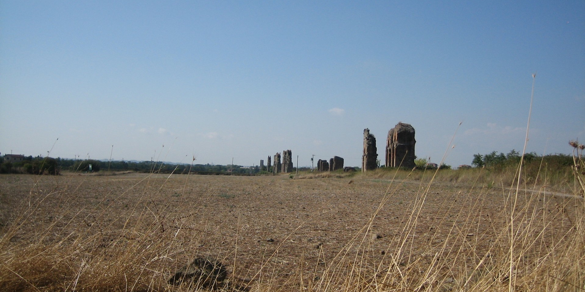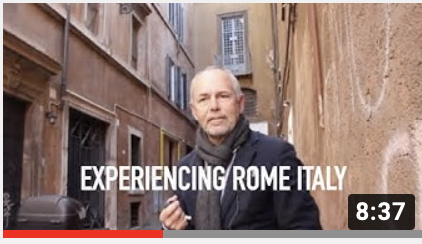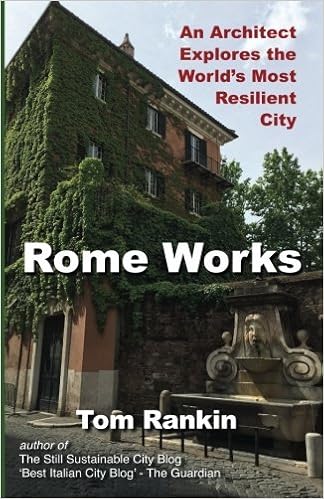Saving the Agro Romano
When it comes to total green area (82,000 hectares or about 275 square meters per capita, 68% of total area of the city) Rome takes the prize. This title of “Greenest European Capital” is deceptive though, deriving more from the fact that the boundary of the city was drawn far out in the hinterland in anticipation of future expansion, thus including within the urban area vast tracts of farmland, land of great ecological value but limited investment value. Sadly, in this very moment when we appreciate the importance of biodiversity, of local food production, of green zones as essential to human inhabitation, the green “capitol” of Italy’s green capital is disappearing like rain forests in Brazil. An more local though more anachronistic analogy that comes to mind is the destruction of antiquities in Renaissance Rome, usually carried out by exactly those humanist patrons who claimed a renewed enthusiasm for antiquities; in a similar manner the speculative growth currently consuming the “campagna romana” is often promoted as “green” (see box below).
According to Lorenzo Romito of Stalker, the long but now accelerating process of destruction of the Roman countryside dates back to the establishment of Roma Capitale in 1870 (Rome as capital of Italy, but capital also in the sense of “wealth in the form of money or other assets”), the result of a long battle fought in the name of “republican” ideals against clerical and noble special interests. In 1870, the royalist and capitalist interests prevailed and the breach in the walls of Rome opened on September 20 let into the city a wave of speculative development which would deface and deform the fabric which had taken two millennia to evolve and seen some of the most sophisticated urban designs, from the proto-modern metropolis of the Roman Empire to the dynamically dispersed city of the Baroque Era. In the place of an either an idea or a design for the city, master plans were enacted and subsequently ignored, easily bypassed by variants and loopholes. Neither was a grass-roots, bottom-up urbanization as often takes place in the developing world possible; where such spontaneous urbanization of unused “blight” areas by the city’s sub-proletariat, a truly Roman phenomenon recognized by Pasolini among others, has taken place the forces of speculation have been quick to suppress any real city-forming tendency in the name of urban renewal. Year after year, with increasing frequency under the city’s former “progressive” left-wing mayor (progress=modernization of real estate speculation) and the city’s current “conservative mayor (conserving the interests of Rome’s rich and powerful), large tracts of rural land guilty of falling within the city limits are (excuse the rhetoric) sacrificed on the altar to cement and automobiles.
A truly green future for Rome will not be based on new “green” real-estate speculation or new “green” parking structures for new “green” automobiles. It must, as a bare minimum, demand, as does London, that any new development be transit oriented but far better would be a moratorium on the sub-urban conversion of rural land. Then the process of urbanization in the true sense–smart, cradle-to-cradle, resource-based, pedestrian-oriented, bottom-up, zero-emissions, eternally-contemporary city-making, can carry on.
Links: Primavera Romana, group working toward goals of sensible, ecological evolution of Rome.http://primaveraromana.wordpress.com/



Here’s a quote from an article I just received by Paolo Berdini, A New Paradigm for our Cities. (roughly translated by me, but available in original Italian at http://eddyburg.it/article/articleview/16494/0/399/
“Once this peculiarly Italian madness that, in the words of Salvatore Settis, immobilizes great wealth has ended, it is necessary to give substance to our proposal. Many, beginning with Guido Viale, have addressed the redirection of production in the environmental sense. I will limit my discussion to the agricultural sector. The great heritage of civic land use, for example, can be handled by cooperatives of young people at rents guaranteed by the regions, and to those who cry “statism” it is sufficient to recall the flood of public money that now flows to “friendly” companies, starting with the Fiat. And then, always at the local level where possible (and in the less populated Apennines this could be done easily) the local authorities could make an intelligent policy of acquisition of abandoned territory. With little money, such as that saved in not having to constantly catch up with continuous urban expansion, one can buy hundreds of acres and return it to agriculture.”
LikeLike
On January 28 a local environmental activist and journalist, Silvio Talarico, was attacked while photographing the unauthorized construction site of a project by the Caltagirone building firm in one of the most pristine remaining areas of the Agro Romano at Tor Pagnotta. The job captain incited construction workers saying “get him or you’ll lose your jobs,” or something to that extent, and workers threw bricks and followed Talarico, beating him in a parking lot, sending him to the hospital. My sympathy and support goes out to him and the thousands, millions of others who are not afraid to intervene with the tools of transparency and information to block illegal construction.
LikeLike